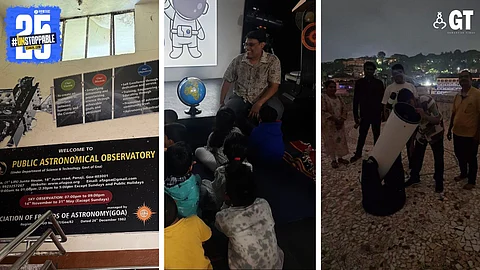

High above the bustling city of Panjim, perched on the topmost floor of Junta House on the busy 18th June Road, the Public Astronomical Observatory has been quietly opening up the skies to Goa’s curious minds.
For years, it has served as a beacon of astronomy education, hosting school visits, training teachers, organising skywatch sessions, and helping demystify the cosmos for ordinary citizens.
But now, the observatory finds itself staring into a void, not the celestial kind, but a deeply terrestrial one. Its home is set to be demolished. And no one knows exactly where it will go next.
“We are literally caught in space, without any space,” says Satish Nayak, who heads the observatory. “Right now, we are functioning on hope.”
We are literally caught in space, without any space. Right now, we are functioning on hope
Satish Nayak, Head of Observatory
YEARS OF EFFORT
The demolition of Junta House has been in the air for a while, but the observatory got its formal notice in April 2025, giving them just one month to vacate.
“Initially, I came to know about it through the newspapers,” Satish recalls. “I immediately wrote to the Department of Science and Technology. The then-director, Ankit Yadav, assured us of full support and logistics, but we were directed to find the space to relocate ourselves.”
This, it turns out, is the real challenge. The observatory spans nearly 550 to 600 square metres, housing a museum, a computer lab, a 4,000-book library, a lecture hall, and a rooftop telescope dome. And it’s not just about moving a few chairs and desks.
“What people don’t realise is that the observatory is more than a telescope. Observations can only be conducted for about 30 per cent of the time,” says Satish. “The remaining 70 per cent is academic work—lectures, training, student visits, board of astronomy studies meetings and planning sessions for all Goa outreach activities. All that needs considerable indoor space too, not just an open terrace.”
What people don’t realise is that the observatory is more than a telescope. Observations can only be conducted for about 30 per cent of the time, the remaining 70 per cent is academic work
Satish Nayak, Head of Observatory
NOWHERE TO GO
The search for a new place has taken Satish all over Panjim. “We met departments, secretaries, even the GAD. Everyone was kind and supportive. But the bottom line is, there’s just no space available that fits our requirements,” says Satish.
And the requirements are not casual. What's required are a flat, open terrace (for telescopic observations) and dome installation, enough indoor room for academic activities, low light pollution, easy accessibility for students, the elderly and the physically challenged. The new place also requires a lift, which is ideal to carry the heavy telescopes and other equipment.
One possible solution after hunting around emerged in the terrace of the Government Polytechnic buildings. But it's on the fourth floor and there is no lift. “During eclipses or meteor showers, 200-250 people come in on an average, including elderly citizens. We also have to carry heavy equipment weekly up and down for outdoor events. Without a lift, it’s just not feasible.”
One possible solution after hunting around emerged in the terrace of the Government Polytechnic buildings. But it's on the fourth floor and there is no lift.
TIME IS RUNNING OUT
For the past few months, the observatory team has been in survival mode. “Astronomy itself has taken a back seat,” Satish admits. “We’ve stopped our usual activities. We aren’t able to do outreach. The whole team is running from department to department, trying to find a solution.”
The monsoon has given a brief reprieve. Observations are paused during the rains, and the open air facility is anyway closed until November 14. But by then, they need to move.
The observatory team has been in survival mode for the past few months. The monsoon has given them a brief reprieve and Observations are paused during the rains.
AND WHAT IF THEY CAN'T?
“God forbid, but if we are shut down, where do I take the books, the instruments, the museum? Where do I put the dome? We are not a formal government department, we’re a unit supported by the Department of Science and Technology. We don’t have a building to fallback on.”
A CALL FOR POLITICAL WILL
The observatory’s last hope may lie in collective action. Satish has already met with Panjim MLA and Science & Technology Minister Babush Monserrate, who has assured support, but reiterated that the appropriate location has to be found first.
“I just want to ask the people in power how do you shift an entire observatory overnight?” Satish says. “Give us a little more clarity, a little more time, a little more help.”
I just want to ask the people in power how do you shift an entire observatory overnight? Give us a little more clarity, a little more time, a little more help
Satish Nayak, Head of Observatory
To the public, he has a simpler message: don’t let this space die.
“This is the only place in Goa where ordinary people—students, families, tourists—can look at Saturn’s rings or see the Moon up close. If we lose this, it won’t come back easily. Science cannot be made to run around looking for shelter.”
Time is running out, and unless urgent action is taken, Goa’s only window to the universe may shut forever.